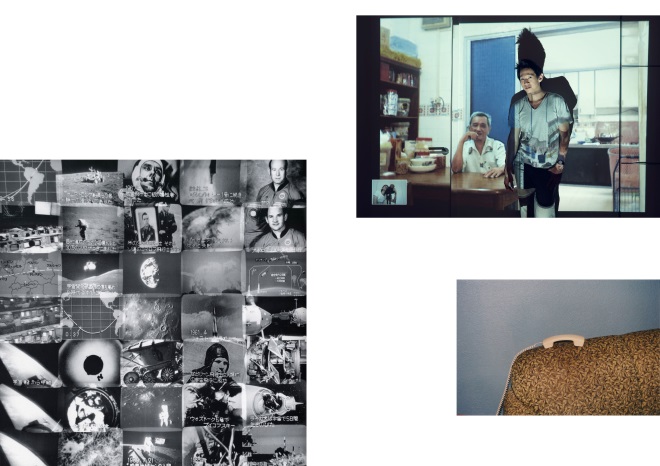Tracing the contours of the interior across countries and through history, the AR draws together intimate moments captured by photographers who look inside for their subjects

Looking in on the landscape 01
Left: one of Jacques Henri Lartigue’s earliest photographs (1904) in which he set his camera afloat in the tub, aged 10. Courtesy of Jacques Henri Lartigue Ministère de la Culture (France), MAP-AAJHL
Right: Martina Mullaney’s Dinner For One series (1998) Courtesy of Martina Mullaney
Locked tight away from the inimical outside, from the air’s mute buzzing, the eye turns in. Photographers point their lenses back towards themselves, towards the home and its happenings, and the camera – as a mechanical tool of hard truth and fixity, of cool representation – becomes also an agent of distortion. Through endless, tireless looking, the intricately known is set to sea as familiar forms shift and expand into broad and alien territories, the lingering image drifting aslant into an uncanny ocean.

Looking in on the landscape 02
Left: Untitled by William Eggleston (c1973) Courtesy of William Eggleston
Right above: In My Room, My Collection of Model Racing Cars (1905) by Jacques Henri Lartigue. Courtesy of Jacques Henri Lartigue Ministère de la Culture (France), MAP-AAJHL
Right below: from Fumi Ishino’s book of photography Rowing a Tetrapod (2018) Courtesy of Fumi Ishino
The eyes go to ground, to rub into carpet bristles’ open field, to crawl. The same desks, chairs and cabinets now loom large, monumental entities taking on the city’s scale with toy trucks to whizz around mouse houses and slip under shoe. The softnesses yielded by the linen’s grain, the droop of the sash and the pink-plumed breeze are unbounded in their feeling. They are too much; swelling, bursting in the lungs. They fleet at the limits of reverie.

Looking in on the landscape 03
Left: between 1975 and 1976 Masao Mochizuki stayed at home and photographed his television screen. Courtesy of Masao Mochizuki / AKIO NAGASAWA Gallery
Right above: in Being Together (2010), John Clang projected the transmissions of his family’s webcams in Singapore onto his own living space in New York City. Courtesy of John Clang / Courtesy FOST Gallery
Right below: Untitled (Nashville) (2017), from Lorena Lohr’s Ocean Sands series. Courtesy of Lorena Lohr
Scenes from the outside are beamed in, accruing in a dense layer of transparency that hangs in thick folds over the familiar structures that make up the home. We are left reaching for loved ones with wires and interconnective networks, distances long and short alike flattening with the projection of parallel realities. Social lines are all imbued with the screen’s unlifely transmission, with the crackle and scratch of a tight electrical coil, a digital ether that encompasses and yet lies slightly out of grasp.

Looking in on the landscape 04
Left: from Laura Letinsky’s Hardly More Than Ever series, taken in 2001. Courtesy of laura letinsky / DOCUMENT / Yancey Richardson Gallery
Right above: Margaret Watkins’ The Kitchen Sink (1919) Courtesy of The Estate of Margaret Watkins / Robert Mann Gallery
Right below: from Martina Mullaney’s Dinner For One series (1998) Courtesy of Martina Mullaney
All around, tall stacks and toppling towers of crockery build up in vast conurbations over every horizontal plane; delicate still lifes constructed in the relentless operations of living, of eating and washing and eating again. Divisions of labour and other ancient genderings are brought bare-boned into exposure as the kitchen’s beating heart flows into the spaces surrounding, the many foodstuffs and their various vessels gathering up in an object array to be picked over or ploughed.

Looking in on the landscape 05
Left above: taken by Khadija Farah as part of The Journal, a collective series run by Women Photograph documenting the lives of women and non-binary photographers in quarantine. Courtesy of Khadija M Farah
Left below: from Performance Under Working Conditions (2003) by Allan Sekula. Courtesy of Allan Sekula Studio
Right: from Sentimental Journey (1971) by Nobuyoshi Araki. Courtesy of Nobuyoshi Araki
Amid this weirding world, this shrunken city, the bed becomes the curtained crux: a stage of sex and sleep and last source of comfort. Quiet intimacies are played out from between its sheets, unfolding in tensely woven bands between cohabitants. Made frayed or tender by constant contact, by aching, inescapable nearness, these gentle abrasions, the peculiar patterns that are drawn in the fabric between, are what will leave a mark.

Looking in on the landscape 06
Practicing Golf Swing (1982) comes from Larry Sultan’s 1992 book Pictures From Home, a memoir documenting both his own life and the lives of his parents. Courtesy the Estate of Larry Sultan / MACK Books / Casemore Kirkeby
This piece is featured in the AR June 2020 issue on Inside – click here to buy your copy today
 The Architectural Review An online and print magazine about international design. Since 1896.
The Architectural Review An online and print magazine about international design. Since 1896.

